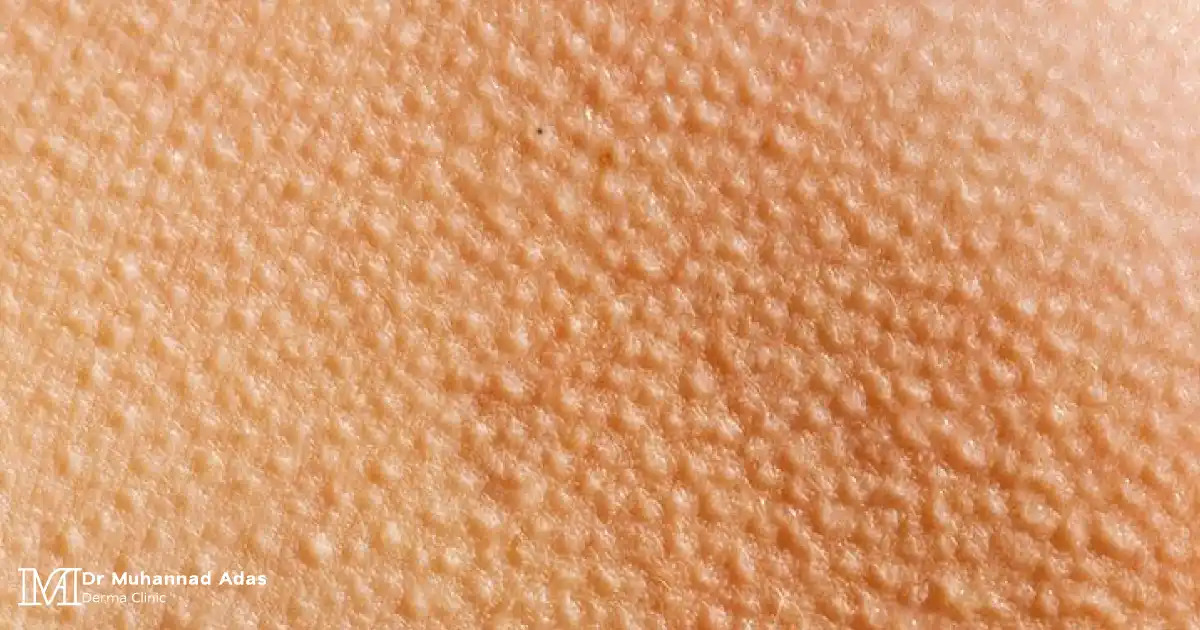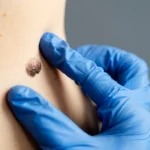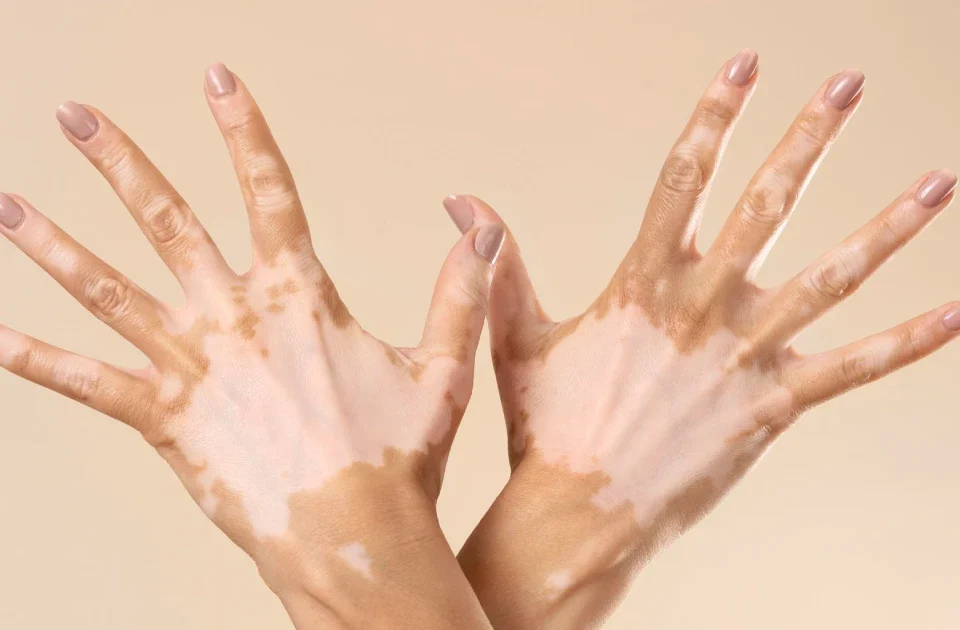Table of Contents
Its names have varied, but the result remains the same. Some named it as “chicken skin,” others call it “keratosis pilaris,” while others use the term “strawberry skin” or “gooseflesh.” It is characterized by annoying bumps on the skin’s surface, indicating an issue that needs to be addressed. So, will the solution be effective? Does this problem require a lengthy treatment journey, or are its treatments quick-acting?
Keratosis pilaris typically affects women more than men, especially pregnant women. Some cases may require treatment, while others may resolve on their own. No quick-acting treatment has been discovered for this condition as of now; however, certain methods can help manage it over relatively long periods or alleviate its symptoms and prevent it.
Chicken skin
Chicken skin, or what is known as Keratosis Pilaris, is a hereditary skin condition where genetic factors may play a significant role in its occurrence. It is scientifically referred to as keratosis pilaris and is considered a non-dangerous and non-contagious condition. It results in the thickening of hair follicles, leading to the accumulation of hair beneath the skin or dead skin cells on the surface. Chicken skin arises from clogged pores, which prevent hair from growing and emerging to the skin’s surface, resulting in the formation of bumps.
There are various factors that influence the occurrence of keratosis pilaris or exacerbate the condition. Winter is often a triggering environment for it due to the increased dryness of the skin during it.
The Appearance of Chicken Skin

Signs of keratosis pilaris appear as small, rough bumps on the skin, which can be bothersome in appearance as well as often being white or red in color, and in some cases, they may match the color of the skin itself. They typically occur on the arms, legs, and buttocks, and some individuals may experience itching in the affected areas.
What is the Cause of Chicken Skin?
Keratosis pilaris occurs due to keratin, a protein found in the skin, which accumulates around hair follicles, causing the condition. This disorder may be hereditary. Several factors can contribute to its appearance, including:
- Genetic factors.
- Clogged hair follicles, leading to hair growing beneath the skin and the formation of bumps.
- Hormonal changes.
- Lack of proper skin care and hydration.
- Incorrect shaving techniques.
- Inflammation of hair follicles.
- Certain skin diseases can trigger keratosis pilaris, such as psoriasis or dermatitis.
- Cold weather, which can lead to dry skin.
- Skin irritation from constant friction between the skin & clothing.
- A deficiency in certain nutrients, such as vitamins A, C, and E, may affect skin health and contribute to the development of keratosis pilaris.
9 Categories Most Prone to Chicken Skin
Certain groups are more susceptible to keratosis pilaris than others, which may be a temporary condition that resolves on its own or may require treatment. These groups include:
- Young individuals and teenagers.
- People with fair skin.
- Those with a family history of the condition.
- Individuals suffering from various skin diseases such as eczema and ichthyosis (fish skin disease).
- Asthma patients.
- Individuals with higher body weight.
- Those affected by hay fever.
- Skin cancer patients.
- Individuals experiencing ongoing hormonal changes.
Important Preliminary Instructions for Treating Chicken Skin
Some cases of keratosis pilaris may require following specific instructions to reduce skin irritation and achieve smoother, better-looking skin which can help prevent keratosis pilaris, manage it, or treat it, such as:
- Avoid shaving with a dull blade.
- Use a moisturizing lotion or shaving cream when shaving.
- Apply moisturizing creams specifically after showering, as the body absorbs them better then.
- Shave in the direction of hair growth.
- Exfoliate and moisturize your skin regularly.
- Use warm water instead of hot water when showering.
- Apply a moisturizing lotion or cream after shaving to soothe the skin.
- If there is inflammation in the hair follicles, consult a dermatologist immediately for treatment to prevent worsening the condition.
- If acne appears, consult a dermatologist for the best treatment method to avoid complications that may affect keratosis pilaris.
Chicken Skin Treatment
As previously mentioned, there is no direct or magical treatment for keratosis pilaris that provides immediate results. However, there are 4 prominent methods for treating it that can significantly help reduce its effects. It is essential to consult a dermatologist for an accurate diagnosis of your condition & to choose the appropriate treatment. So, how can one get rid of keratosis pilaris?
Moisturizing Creams
Moisturizing creams can help treat keratosis pilaris, especially when incorporated into a daily skincare routine. Keratosis pilaris tends to affect skin that exhibits dryness and its various complications, such as itching & flaking. Therefore, maintaining skin hydration is the most crucial key in managing or treating keratosis pilaris.
Medical Creams
When confirming the symptoms you are experiencing with keratosis pilaris, such as the formation of bumps & their appearance, one of the most important steps is to consult a dermatologist. The dermatologist may recommend applying therapeutic creams to the skin, which should only be used after consultation, as they can potentially cause irritation and damage to the skin.
Important ingredients that should be in medical creams:
- Urea.
- Alpha Hydroxy Acids (AHAs).
- Topical Vitamin A.
- Lanolin.
- Ammonium Lactate.
- Chemical-free ingredients like almond oil or coconut oil.
Skin Exfoliation Products
Exfoliators are beneficial in treating keratosis pilaris, as they help remove dead skin that can accumulate on the skin’s surface, leading to clogged pores and the buildup of keratin and development of keratosis pilaris.
Skin exfoliation products ingredients
- Alpha Hydroxy Acid.
- Lactic Acid.
- Salicylic Acid.
- Uric Acid.
It is also important to consult a dermatologist before starting to use skin exfoliation products to prevent any complications or skin irritations.
Treatment via Laser
Keratosis pilaris can often be effectively treated with laser therapy, which is considered one of the most effective treatments. Laser treatment works by reducing redness and irritation associated with the condition, in addition improving the overall appearance of the skin.
There are various types of lasers & devices used for this purpose, so it is essential to consult a qualified physician to choose the appropriate type of laser, as some lasers are designed to reduce swelling and redness, while others may alleviate skin irritation or minimize brown spots that can appear after the removal of these bothersome bumps. If no results are observed within 4 to 6 weeks of following the treatment plan, it is essential to consult the doctor or specialist for further evaluation.
In order to effectively treat keratosis pilaris with laser therapy, some specialists recommend using creams that promote skin exfoliation and help remove dead skin before starting the sessions. It is essential to consult a dermatologist before using these creams, which should contain the following ingredients:
- Lactic Acid.
- Alpha Hydroxy Acid (AHA).
- Salicylic Acid.
- Urea Cream.
In conclusion, keratosis pilaris or chicken skin, is a condition that can be bothersome for those affected and may cause various feelings of embarrassment. It can be treated starting with a consultation with a dermatologist, who can provide guidance on the appropriate treatment plan to speed up the healing process. While keratosis pilaris may resolve on its own, the treatment journey can be lengthy; therefore, it is essential to remain confident that your issue will be resolved, provided you adhere to specific instructions and follow the correct treatment plan.
If you are looking for a dermatologist to assist you in treating keratosis pilaris and various cosmetic procedures, consider consulting Dr. Mohannad Adas, a skilled and specialized dermatologist. To make an appointment, call the clinic at +962799377600.
You can also browse various blogs on our website related to dermatological conditions and both surgical & non-surgical cosmetic procedures at: dradas.com.




